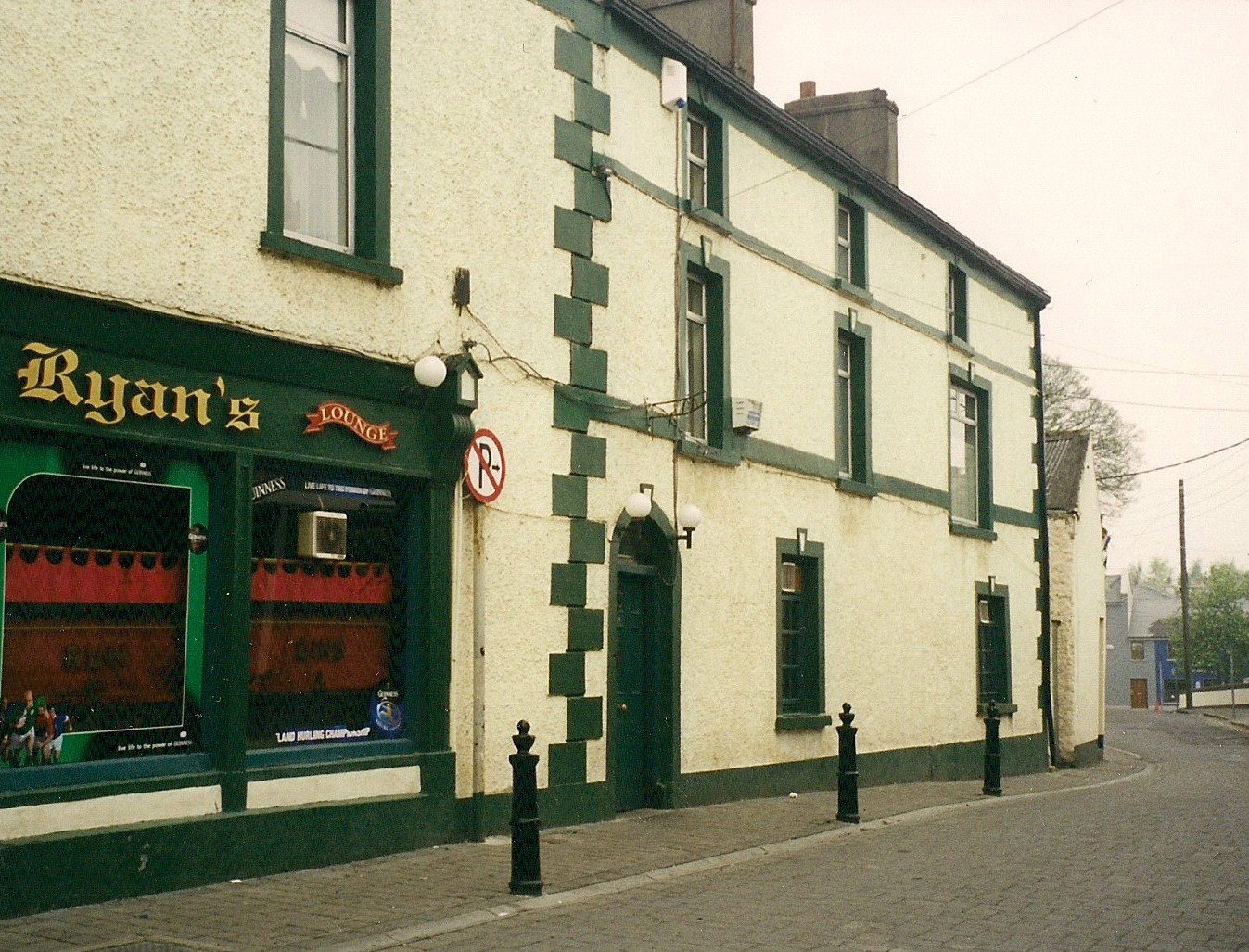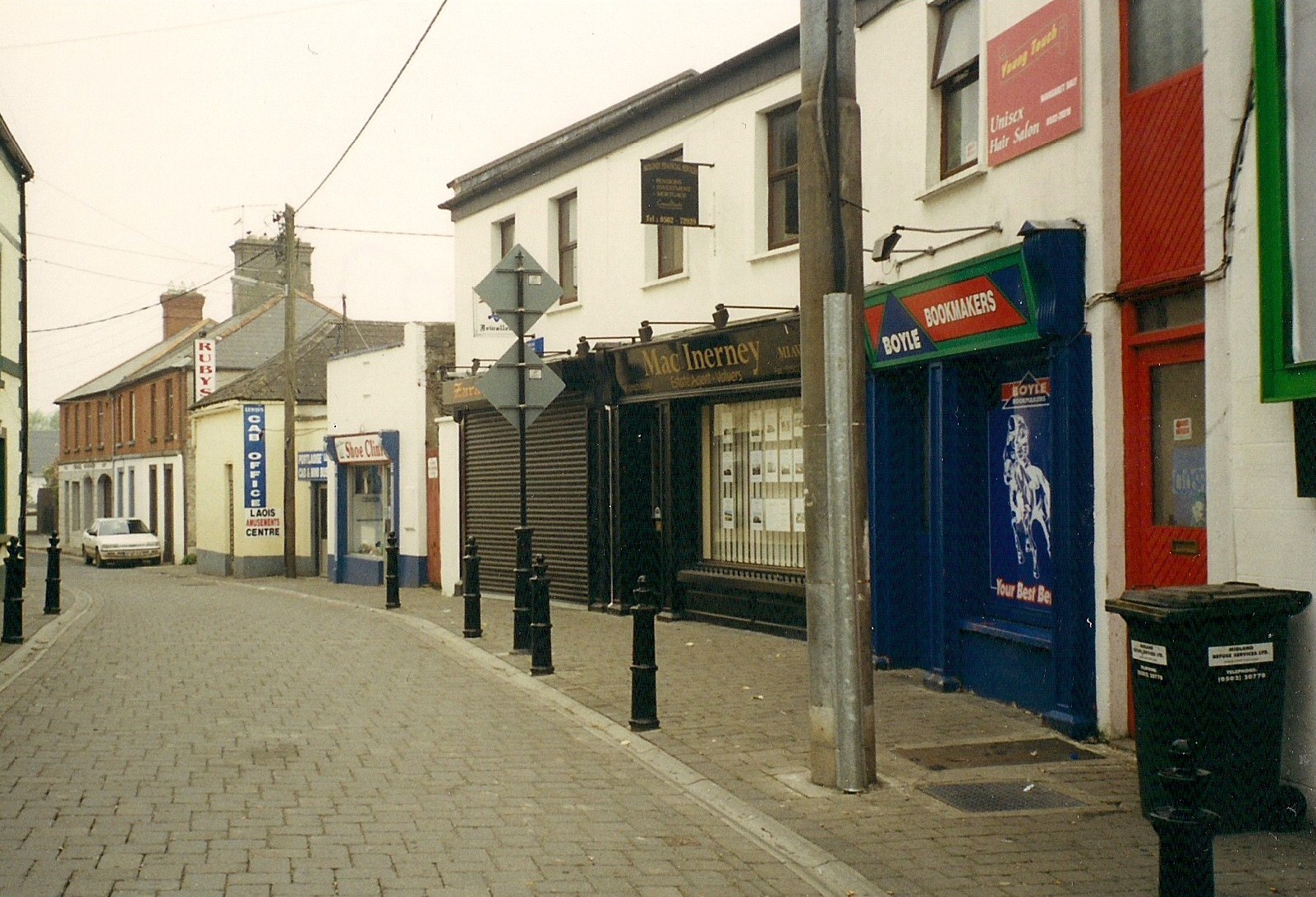
When Railway Street was officially given this name remains something of a mystery. Despite the fact that the railway had arrived more than half a century earlier, the street still appeared as "Church Lane or Mathew's Lane" in both the 1901 and 1911 census. The section from Main Street to St Peter's Churchyard was, apparently, once called Hackett's Lane, but I have never seen this name on any official document and have no idea of its provenance. Prior to the 1840's, the lane was a cul-de-sac with a house built across it. It was known as the Stephouse (because there were steps up to it??) and was the home of a one-legged harness-maker who - depending on which of my unofficial sources is correct - was saddled with the name Stickleg or Stickfoot. Rightly or wrongly, this Mr Kelly has endured in the folk memory as the man who hid in his cellar to escape his harridan of a wife. Just beyond the last cream-coloured building on the left stood, until 2011, the town's Dole Office1. The man behind the counter there for many years was Kevin O'Rourke, but what might not be well known is that he was once a musician with various showbands, most prominently The Vikings from Carlow. Search the Internet and you'll find a picture of the lads posing on the steps of Carlow Courthouse. Unlike, say, The Cadets or The Indians, whose outfits matched their names, there's not a sheepskin jerkin or a horned helmet in sight; just eight shiny smiles and jackets and, there, in the back row, all Beatle haircut and Fender Precision bass, is our civil servant by day and musician by night. Kevin subsequently managed The Black Knights - with townies Willy O'Reilly and Donal Bland on lead and rhythm guitars - who evolved into The Knights, the first band from Portlaoise to release a single (1969). The A-side (there's a blast from the past!) was If You Could Love Me, written by Portarlington-man Michael Turley and sung by Seamus 'Rack' O' Brien. (You can hear an excerpt on the Local Musicians page of this website.) Seamus and Kevin were neighbours growing up and, continuing the Railway Street connection, the latter's sister Evelyn was one of the backing singers on the B-side, Not Any More, of that historic record. The others were Lindy Foster from the Market Square and the late Mary Bennett from Main Street. The distinction, incidentally, of being the first person from the town to release a record - way back in the 1920's - belongs to Patrick Ward. We'll hear more about him later in this project. Adjacent to the Dole Office - in a perfect example of the co-existence of God and Mammon? - is the more-often-than-not neglected old St Peter's Churchyard. Its ruined tower, all that remains of the Catholic church built shortly after the Plantation of Laois in 1556, is one of the town's oldest structures. Apart from short stints under Catholic control, it served as a Protestant church until the completion of the new St. Peterís in the Market Square in 1804.

The furthest of the three red-brick houses is the home and bicycle shop of Denis Kavanagh. Established by his father Michael (who, like my father, once worked in Aird's in the Lower Square), the shop, predictably and affectionately known as 'Spokes Kavanagh's', is another of the town's landmark businesses. In 1911, it was the home of John Bunyan from County Longford, his wife Hannah from Limerick, and their eight children. He also built the house, as well as the others in the terrace. On the far side of Kavanagh's, the site now occupied by the Educate Together school, (and, prior to that, the 1960's extension of the old Technical School) was, well into living memory, a pound for stray animals. 'Keeper' of the pound was Johnny Kavanagh whose house and front wall (which was actually part of the old town wall), are long since demolished. I was told the story of how an old man, remembered only as Saint John2, once made wooden spinning tops in a small workshop in this street. In an instant, my head filled with visions of a fairytale Geppetto, working into the night, shaping the toys he'd sell on Market Day in the Square. I wondered whether, somewhere in the town, in the corner of some dusty attic, there were still examples of Saint John's handiwork. But research revealed a more prosaic reality. In 1911, Thomas St. John and his sister Sarah, formerly of Quality Row (Grattan Street today) were living in nearby Church Street. He was indeed a carpenter, and maybe he did make tops... But somehow the historical actuality robs the original story of its emotional potency. In other words, how history is presented, the very language and tone used, is as crucial as its content. But I still wonder about those attics....
1 It's ironic that the new - and newly-titled - Department of Social Protection premises in Church Street are located next-door-but-one to the building that housed the town's very first Dole Office. Unemployment benefits, incidentally, were introduced in 1911. 2 In a variant I've heard of this story, he appeared - because of his white beard - as Saint Joseph. |
 |
 |
| HOMEPAGE |